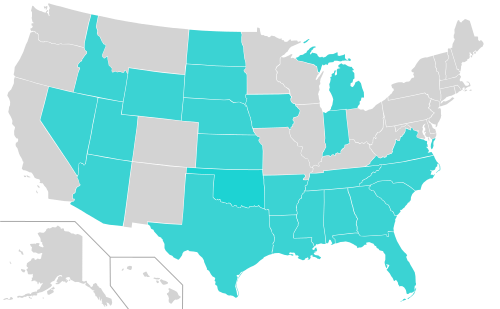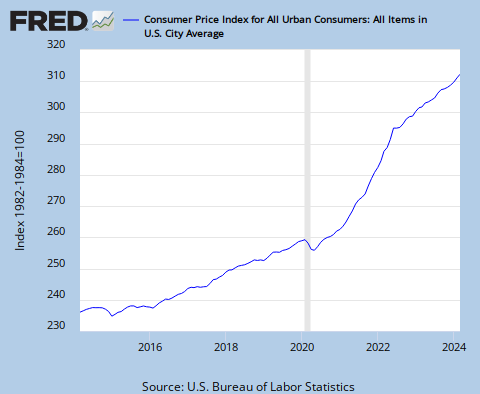Betsy Russell at the Idahoan Spokesman-Review offers some informed speculation, drawing on a few high-profile political scientists.
HT: Seth Masket.
Thursday, May 26, 2011
Wednesday, May 25, 2011
Apples, oranges, and right-to-work
Don Ewing at GraniteGrok argues that right-to-work laws decrease unemployment, increase personal income growth, and increase private sector employment.
But Don forgets that correlation does not imply causation.
In real life, states with right-to-work laws differ systematically from states without them, and this invalidates the comparisons.
Wikipedia has a convenient map of right-to-work states (in blue):

Clearly these states are not randomly distributed across the map, leaving plenty of room for geographical factors to influence the numbers (notably unemployment rates).
The personal income measure used by the BEA— I think this is what Ewing was referencing— is the sum of all income earned, meaning that immigration patterns influence the growth rates. (A growing population leads to a higher total personal income.) And, according to research by Harvard economist Edward Glaeser, among others, one of the main determinants of immigration is the elasticity of the housing supply— that is, how easy it is to build new houses as the price of houses increases. For all we know, personal income growth in right-to-work states is being driven by the housing market. The same applies to growth in private sector employment.
Or the differences could be driven by one of a thousand other factors.
From what I've seen, using statistics to tease out the effects of particular state policies is ridiculously hard to do, and requires a much stronger statistical background than I have. This is a lot of the reason why I didn't even broach the subject in my union essay.
A quick search for an academic analysis of the issue found only this paper by Thomas Holmes. By comparing bordering counties in different states, he finds that a business-friendly regulatory climate increases the share of employment in manufacturing by about one third. But this study looks only at manufacturing, and only at counties on the borders of states (which means the estimate is inflated by an unknown amount). And the contribution of right-to-work laws to business-friendly regulatory climates is unknown.
So we can guess that right-to-work laws will increase the share of our employment in manufacturing by anywhere from zero to one-third. Which doesn't get us very far.
But Don forgets that correlation does not imply causation.
In real life, states with right-to-work laws differ systematically from states without them, and this invalidates the comparisons.
Wikipedia has a convenient map of right-to-work states (in blue):

Clearly these states are not randomly distributed across the map, leaving plenty of room for geographical factors to influence the numbers (notably unemployment rates).
The personal income measure used by the BEA— I think this is what Ewing was referencing— is the sum of all income earned, meaning that immigration patterns influence the growth rates. (A growing population leads to a higher total personal income.) And, according to research by Harvard economist Edward Glaeser, among others, one of the main determinants of immigration is the elasticity of the housing supply— that is, how easy it is to build new houses as the price of houses increases. For all we know, personal income growth in right-to-work states is being driven by the housing market. The same applies to growth in private sector employment.
Or the differences could be driven by one of a thousand other factors.
From what I've seen, using statistics to tease out the effects of particular state policies is ridiculously hard to do, and requires a much stronger statistical background than I have. This is a lot of the reason why I didn't even broach the subject in my union essay.
A quick search for an academic analysis of the issue found only this paper by Thomas Holmes. By comparing bordering counties in different states, he finds that a business-friendly regulatory climate increases the share of employment in manufacturing by about one third. But this study looks only at manufacturing, and only at counties on the borders of states (which means the estimate is inflated by an unknown amount). And the contribution of right-to-work laws to business-friendly regulatory climates is unknown.
So we can guess that right-to-work laws will increase the share of our employment in manufacturing by anywhere from zero to one-third. Which doesn't get us very far.
Monday, May 23, 2011
Our modest recession
Changes in unemployment from 2007 to 2010, by state:

According to Paul Krugman, New Hampshire fared well, at least in part, because it's a "cold [place] where nobody lives".
... Guess we can't have it all.

According to Paul Krugman, New Hampshire fared well, at least in part, because it's a "cold [place] where nobody lives".
... Guess we can't have it all.
Wednesday, May 4, 2011
Why I wouldn't bet on a currency crisis
Denis Goddard on Capitol Access argues that the dollar is collapsing, and we're headed toward hyperinflation:
This comes after a variety of predictions of hyperinflation over the last few years, none of which have panned out. I don't think this one will, either.
First, the data. Here is the Consumer Price Index, which measures inflation:

The trend over the last year or so should be taken with a grain of salt, because the CPI includes the prices of goods, such as gas and food, which vary greatly in response to changes in, for example, the weather or international politics. The core CPI, which excludes the more variable prices and is therefore a better measure of long-term inflationary trends, shows lower inflation than this graph. I'm showing the more inclusive, volatile CPI only because I don't want to be accused of underestimating inflation. (The Boston Fed has recently released research confirming that commodity prices do not predict long-term inflation.)
Here is the value of the dollar relative to other currencies:

Here is the interest payed on 10-year treasury bonds:

This suggests that the bond market expects inflation over the next 10 years to be a whopping 3.46%, or even less. [Edit: Unless real interest rates are negative, which is possible. However, we can use the interest payed on inflation-indexed bonds to estimate the real interest rate, and the latest figure is .86%. The difference between the two rates, the "spread", should approximately equal expected inflation. This suggests an expectation of 2.6% inflation over the next 10 years— shockingly low.]
None of these measures looks especially frightening. And the situation is unlikely to deteriorate, for multiple reasons.
First, the Fed is well prepared to fight inflation. If inflation starts rising significantly, it can sell some of its $2.7 trillion worth of assets for dollars, reducing the money supply. And thanks to the way fractional reserve banking works, when the Fed removes currency this way, the effect is multiplied, so that removing $2.7 trillion dollars shrinks the money supply by much more than $2.7 trillion. Taking money out of the economy also increases interest rates, which is what commentators usually refer to.
The Federal Reserve famously used this strategy in 1980 and '81 to eradicate the high inflation of the 1970s. In fact, it was so successful that the disinflationary pressures caused a recession. (Though preventing inflation is much easier than reducing it, so we needn't worry about another Fed-induced recession.)
The Fed can also raise reserve requirements for banks. This would lower the money multiplier, which would lower the money supply. And, as of 2008, the Fed can pay banks interest on their excess reserves— basically, pay them to not lend out money— which allows the Fed to more easily fine-tune inflation rates and the money supply.
Besides the Federal Reserve, another force will likely intervene to prevent a collapse of the U.S. dollar. If the dollar drastically depreciates (that is, loses value with respect to other currencies), the European Central Bank will probably expand the supply of Euros in an attempt to stabilize exchange rates. Why? Because, if the dollar depreciates, American goods become cheaper, and European goods become relatively more expensive, leading to higher American exports and lower European exports. This would harm the European economy. (In fact, the European Central Bank is already responding this way.) Other U.S. trading partners face the same incentives.
So probably no currency collapse any time soon.
(Hat tip to Dean Baker and Paul Krugman, and Paul Krugman again, for some data and arguments.)
This comes after a variety of predictions of hyperinflation over the last few years, none of which have panned out. I don't think this one will, either.
First, the data. Here is the Consumer Price Index, which measures inflation:

The trend over the last year or so should be taken with a grain of salt, because the CPI includes the prices of goods, such as gas and food, which vary greatly in response to changes in, for example, the weather or international politics. The core CPI, which excludes the more variable prices and is therefore a better measure of long-term inflationary trends, shows lower inflation than this graph. I'm showing the more inclusive, volatile CPI only because I don't want to be accused of underestimating inflation. (The Boston Fed has recently released research confirming that commodity prices do not predict long-term inflation.)
Here is the value of the dollar relative to other currencies:

Here is the interest payed on 10-year treasury bonds:

This suggests that the bond market expects inflation over the next 10 years to be a whopping 3.46%, or even less. [Edit: Unless real interest rates are negative, which is possible. However, we can use the interest payed on inflation-indexed bonds to estimate the real interest rate, and the latest figure is .86%. The difference between the two rates, the "spread", should approximately equal expected inflation. This suggests an expectation of 2.6% inflation over the next 10 years— shockingly low.]
None of these measures looks especially frightening. And the situation is unlikely to deteriorate, for multiple reasons.
First, the Fed is well prepared to fight inflation. If inflation starts rising significantly, it can sell some of its $2.7 trillion worth of assets for dollars, reducing the money supply. And thanks to the way fractional reserve banking works, when the Fed removes currency this way, the effect is multiplied, so that removing $2.7 trillion dollars shrinks the money supply by much more than $2.7 trillion. Taking money out of the economy also increases interest rates, which is what commentators usually refer to.
The Federal Reserve famously used this strategy in 1980 and '81 to eradicate the high inflation of the 1970s. In fact, it was so successful that the disinflationary pressures caused a recession. (Though preventing inflation is much easier than reducing it, so we needn't worry about another Fed-induced recession.)
The Fed can also raise reserve requirements for banks. This would lower the money multiplier, which would lower the money supply. And, as of 2008, the Fed can pay banks interest on their excess reserves— basically, pay them to not lend out money— which allows the Fed to more easily fine-tune inflation rates and the money supply.
Besides the Federal Reserve, another force will likely intervene to prevent a collapse of the U.S. dollar. If the dollar drastically depreciates (that is, loses value with respect to other currencies), the European Central Bank will probably expand the supply of Euros in an attempt to stabilize exchange rates. Why? Because, if the dollar depreciates, American goods become cheaper, and European goods become relatively more expensive, leading to higher American exports and lower European exports. This would harm the European economy. (In fact, the European Central Bank is already responding this way.) Other U.S. trading partners face the same incentives.
So probably no currency collapse any time soon.
(Hat tip to Dean Baker and Paul Krugman, and Paul Krugman again, for some data and arguments.)
Subscribe to:
Posts (Atom)